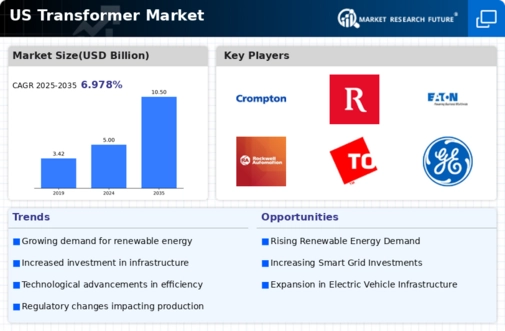Rising Energy Consumption
The increasing energy consumption in the US is a critical driver for the transformer market. As the population grows and urban areas expand, the demand for electricity continues to surge. According to the US Energy Information Administration, electricity consumption is projected to increase by approximately 1.5% annually over the next decade. This rise in demand necessitates the installation of additional transformers to ensure a stable and reliable power supply. Consequently, utility companies are likely to invest in upgrading existing transformer systems and deploying new ones, thereby stimulating growth in the transformer market. This trend indicates a robust opportunity for manufacturers to innovate and provide solutions that cater to the increasing energy needs.
Focus on Energy Efficiency
The growing emphasis on energy efficiency is a notable driver for the transformer market. As energy costs rise and environmental concerns become more pressing, both consumers and businesses are seeking ways to reduce energy consumption. The US government has implemented various initiatives aimed at promoting energy-efficient technologies, including transformers. The Energy Policy Act mandates that transformers meet specific efficiency standards, which has led to an increased demand for high-efficiency transformers. This regulatory push is likely to drive innovation in transformer design and manufacturing, as companies strive to develop products that not only comply with regulations but also offer superior performance. The focus on energy efficiency is expected to significantly influence the transformer market in the coming years.
Expansion of Renewable Energy Sources
The expansion of renewable energy sources in the US is poised to have a profound impact on the transformer market. As the country transitions towards cleaner energy solutions, the integration of renewable energy sources such as wind and solar power into the grid necessitates the use of specialized transformers. These transformers are essential for managing the variable output from renewable sources and ensuring stable electricity supply. The US Department of Energy has set ambitious targets for renewable energy adoption, aiming for 50% of electricity generation to come from renewable sources by 2030. This shift is likely to drive demand for transformers that can efficiently handle the unique requirements of renewable energy systems, thereby creating substantial growth opportunities within the transformer market.
Infrastructure Development Initiatives
The ongoing infrastructure development initiatives in the US are likely to bolster the transformer market. With the government investing heavily in upgrading and expanding the electrical grid, the demand for transformers is expected to rise. The Biden administration's infrastructure plan allocates approximately $1 trillion for various projects, which includes significant funding for energy infrastructure. This investment is anticipated to enhance the reliability and efficiency of power distribution, thereby increasing the need for advanced transformer technologies. As the transformer market adapts to these developments, manufacturers may focus on producing more efficient and durable transformers to meet the evolving demands of the infrastructure sector.
Integration of Smart Grid Technologies
The integration of smart grid technologies is transforming the landscape of the transformer market. Smart grids utilize advanced communication and automation technologies to enhance the efficiency and reliability of electricity distribution. As utilities in the US increasingly adopt these technologies, the demand for smart transformers is expected to rise. These transformers are equipped with monitoring and control capabilities that allow for real-time data analysis and improved operational efficiency. The market for smart transformers is projected to grow at a CAGR of around 10% over the next five years, driven by the need for enhanced grid management and reduced operational costs. This shift towards smart grid solutions presents a significant opportunity for innovation within the transformer market.





















Leave a Comment